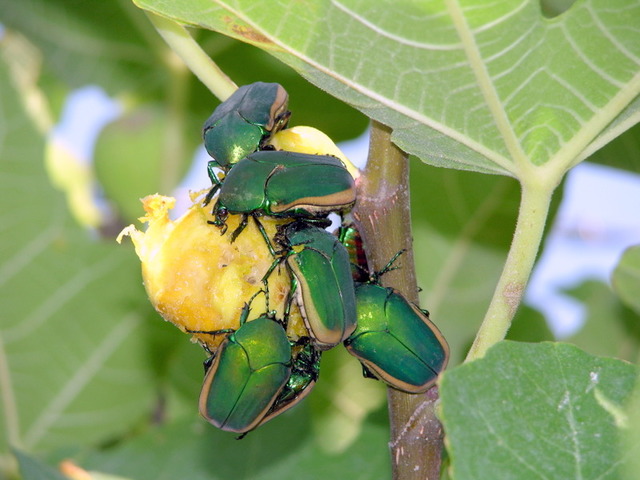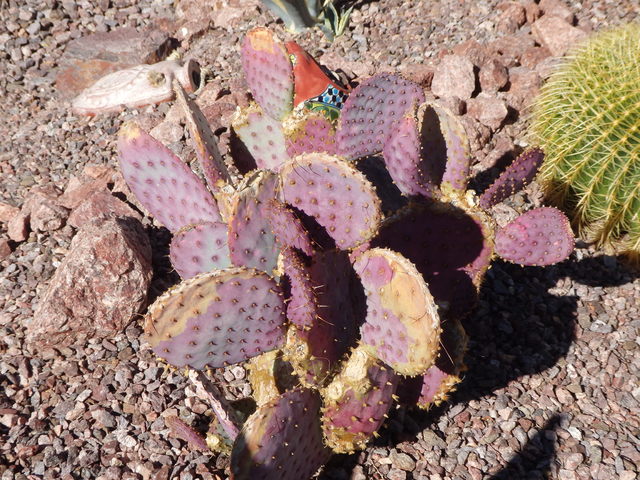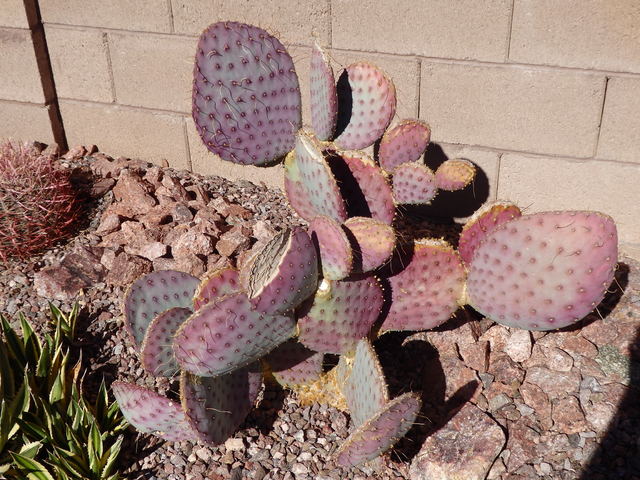Sprinkle granular insecticides this time of year to control pests
Fall and early winter are excellent times to prevent insect problems that occur next year. I received reports of worms or grubs feeding now on the roots of plants. The most common are white grubs.
White grubs found now pupate, or change into adults, over the winter. The adults of these white grubs are sometimes referred to as chafers in the much larger category of scarab beetles.
The most common to many Midwesterners is the June beetle. Desert dwellers who have lived here a long time might think of the metallic green June beetle that attacks soft fruit during the summer. But these pests come in a variety of colors, sizes and some even with racing stripes.
The fastest way to control these insects is to sprinkle granular insecticides that are specifically labeled for grubs or insects feeding on roots. Follow label directions, but normally the insecticide is washed into the soil from the granules with a light application of water. If you can’t find granules, use a liquid applied to the soil as a drench that protects roots.
If you prefer an organic or more natural approach, look for beneficial nematodes or bacteria that can be applied to the soil around these plants. They are quite common in most nurseries and garden centers. This approach gives a slower kill but is just as effective as commercial insecticides over time plus the application persists in the soil for a much longer time.
Lantana is the most common plant attacked as reported by many readers. White grubs evidently love lantana’s roots. It is a safe bet if these plants were struggling this past summer, the roots are probably under attack by white grubs.
Control of Bermuda grass and other nasty weeds that resist removal by hoeing are better controlled during the fall than any other time of year. Make sure these weeds are “happy” before applying systemic weed killers.
Water and fertilize them lightly a week before applying systemic weed killers. Apply weed killers at the label rate, and do not exceed it. Applying more than recommended is not merely wasteful but will work against the effectiveness of these chemicals.
Q: Two of our three beaver tail cactus clumps have multiple dying paddles. We don’t fertilize the cactus. All three are watered the same; in extreme heat, once every 1½ weeks; moderate heat, every 2 to 3 weeks; and nothing during winter. All receive approximately 1½ gallons each time they are irrigated. All are planted on mounds that drain.
A: If I were only shown the pictures you sent with no explanation, I would come to these conclusions: freezing damage from previous winters because of the damage to the edges of the paddles, no soil improvement combined with watering problems, and poor growth due to a lack of nitrogen fertilizer.
Most of the damage to the pads is environmental, not caused by insects or diseases. The pads’ condition will improve by using soil amendments, watering and applying fertilizers. They like soil improvement at the time of planting. But if watered too often they will die.
Plant beaver tail cactus from a single pad during the heat of the summer, not the fall or winter months. Amend the soil with either compost or manure before planting. Use a 50/50 mix when amending the soil.
I’m glad to hear they are planted on a mound if drainage is a problem. But I plant them on level ground if the soil is amended at planting time.
Amending the soil does two things in addition to providing nutrients. It holds water but at the same time improves drainage. This concept can be difficult to accept, but this is the magic of soil amendments when used in our very poor soils.
Harvest mature pads at their joint or nodes, making sure to not damage the pad. Do not leave any traces from the mother pad remaining on the harvested pad. The joint or node should be smooth and not ragged.
Harvesting a pad is done easily by grasping the pad with newspaper and bending the pad almost to the point of splitting through the joint. Then lightly touch this joint with a very sharp, sanitized knife.
When done this way, the harvested pad separates easily and quickly from the mother pad at the joint. If it doesn’t and the joint is ragged, trim the joint being careful not to cut into the harvested pad. Extra ragged pieces will only rot and possibly cause problems.
Do this in the early summer, not the fall or winter. Put the pad in the shade for three days to a week, oriented either upright or turn the pad over daily to keep it from curving. The pad will continue to grow after harvesting so keeping the pad from curving becomes important at planting time.
The other option is to dip or dust the cut end of the pad in a fungicide such as a copper-based fungicide. The pad is planted in the amended soil upright so that the edges are oriented north and south. This gives equal opportunity for one side of the pad to receive morning sun and the other side to receive afternoon sun.
Once planted, water deeply every three weeks during the summer, not more often than this. To do this, put a basin around the planted pad about 2 feet in diameter to hold the irrigation water. Fill the basin with 2 to 3 inches of water and let it drain into the soil.
The next irrigation is three weeks later. Watering more often than this can cause the cactus to become top-heavy and fall over.
Planting and watering a single cactus pad every three weeks, even during the summer months, should get the new cactus 3 feet tall in one growing season. Once the cactus is the size you desire, water less often and remove pads if it gets too tall.
Once the cactus is established, fertilize once a year. To push size and height, use a high-nitrogen fertilizer. Once the cactus is the size you desire, switch to a low-nitrogen fertilizer such as the kind you use for roses or growing tomatoes. Apply the same amount of water but apply it less often.
Q: I have heard you mention applying fertilizer to trees and shrubs in the fall rather than spring. Is now the right time to do that?
A: The concept is called late fall fertilization. It first came to light in the management of lawn grasses. The effects from nitrogen fertilizers applied in late fall could be stored over the winter. In the spring, these effects would kick in and get the lawn off to an early start without an applied fertilizer.
This concept was applied to landscape plants and it worked. If high-nitrogen fertilizers were applied in late fall, the effects would be delayed until the following spring. This can be applied to fruit trees as well.
Why not apply fertilizers in the spring? The primary reason, commercially, is labor. Springtime frequently is a very labor-intensive time of the year for professionals. Late fall months, before pruning begins, is usually a slow time of year. Taking spring operations and moving them to fall redistributes labor.
Timing is critical. Time late-fall fertilization when growth has stopped or nearly stopped but before leaves have begun to lose color. Plants should not be growing but leaves should still pull water from the soil to distribute these effects throughout the plant and into storage. Avoid late-fall fertilizing on winter-tender plants in our climate that are woody such as citrus, bougainvillea and Cape honeysuckle.
Bob Morris is a horticulture expert living in Las Vegas and professor emeritus for the University of Nevada. Visit his blog at xtremehorticulture.blogspot.com. Send questions to Extremehort@aol.com.

























